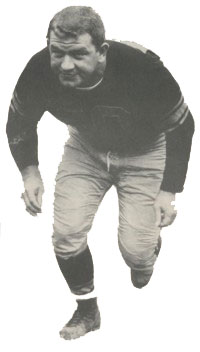 |
John Reger |
The Pittsburgh Steelers in two years have undergone the most complete personnel shake-up on record for a peace-time National Football League club. The following article describes the hectic operations by which Buddy Parker arrived at the team that thrilled Pittsburgh at the close of the 1958 season.
Of the thirty-five man squad Buddy Parker inherited upon coming to Pittsburgh in 1957, only twelve remain. The offensive hold-overs are three: Ray Mathews, Frank Varrichione and Jack McClairen. But this tells only part of the incredible turnover of the Steelers under Parker. No less than forty eight players have come and gone who represented Pittsburgh in league competition action.
Parker's house cleaning began immediately upon his arrival at the Steeler camp. It was quite apparent that the club needed offensive help. Outright purchases of talent were all but impossible. Pro coaches, whose jobs depend upon won and lost records, show a not too surprising lack of interest in deals that increase the club coffers without strengthening the team itself.
Forced to deal for player talent and unwilling to surrender certain of his own squad, Parker turned to the foundation of a pro team's future, the draft choice. Working on the premise that a pro on hand was worth two possible future stars playing in the collegiate bushes, Parker traded choices feverishly. Nine different players were obtained for draft choices.
Ironically only Ed Beatty for whom a 13th choice was given and Mike Sandusky, a part of the Earl Morrall trade, still remain. The other seven have been since either released or retraded.
Desperate for a quarterback, Parker agreed to the rather stiff terms of the San Francisco 49ers. The Steelers' first draft choices in 1958 and 1959 and Marv Matuszak, an outstanding linebacker, went to the 49ers for Morrall and Sandusky. As the season started Parker continued to trade and did so on a game to game basis.
At the close of the six-won, six-lost 1957 season it was generally felt that Parker had been "stung" on the Morrall deal and that other trades had fallen somewhat short of expectations.
Completely oblivious to this, Parker rushed into a flurry of trades that became almost comical in their complexity. Billy Wells had been obtained for Parker's seventh choice in 1959. Fred Bruney was traded to Washington for the return of the seventh choice provided Bruney made the Redskin squad.
While this condition was still pending, Parker dealt away the choice for Tom Tracy. When Bruney was released by the Redskins, Parker had to give his sixth choice to Detroit. Tracy, Orr, Christy and Billy Ray Smith all were obtained early in the season for draft choices.
But the most important trade, of course, was the exchange of Earl Morrall plus the second choice in '59 and the fourth choice in '60 for the services of Detroit quarterback, Bobby Layne. Those who remembered Morrall's high price tag pointed out that Parker had actually surrendered his No. 1 choice in 1958, the No. 1 and the No. 2 choice in 1959 and the fourth choice in 1960 for a thirty-one year old veteran.
Whatever the cost, Layne proved well worth it. The Steelers swept through their final seven games without a loss. A defeated proposal at the league meetings provided conclusive evidence of the success of Parker's "Bird in the Hand" theory. The suggestion, from none other than Paul Brown, would have limited all pro clubs in the trading of future draft choices.
Story from the August 11th programme for the 4th Annual Shrine game.
Editor's note: The Steelers won both the 1959 encounters. First, 17-7 at home and then 21-20 in Cleveland. All the scores from every Browns game can be found on our sister web site, pittsburghsteelers.co.uk. I will eventually copy it across to this site, but have left the current pages intact because they do come up in search engines results.